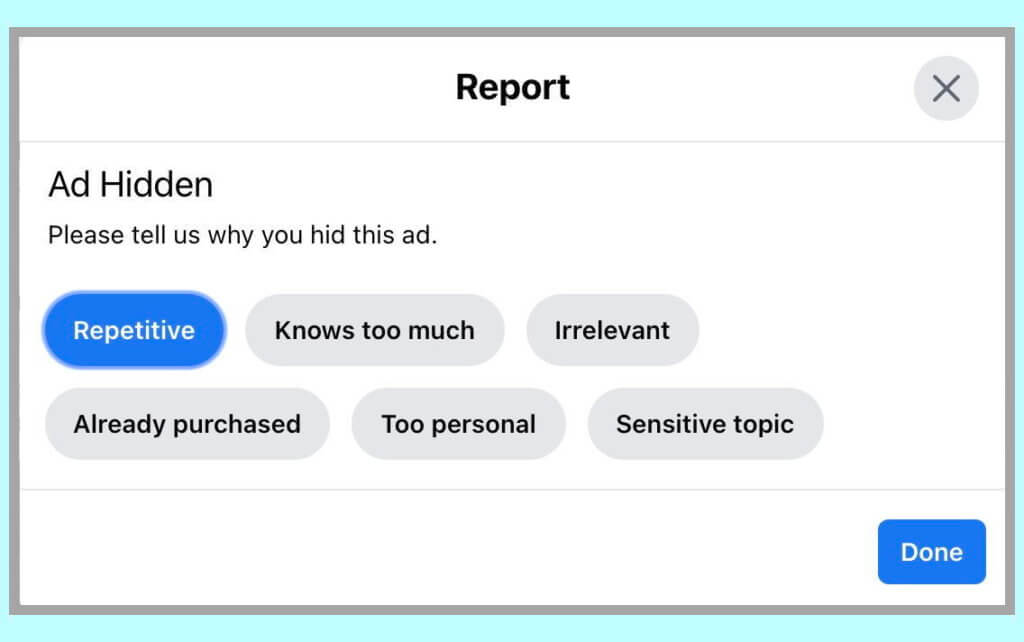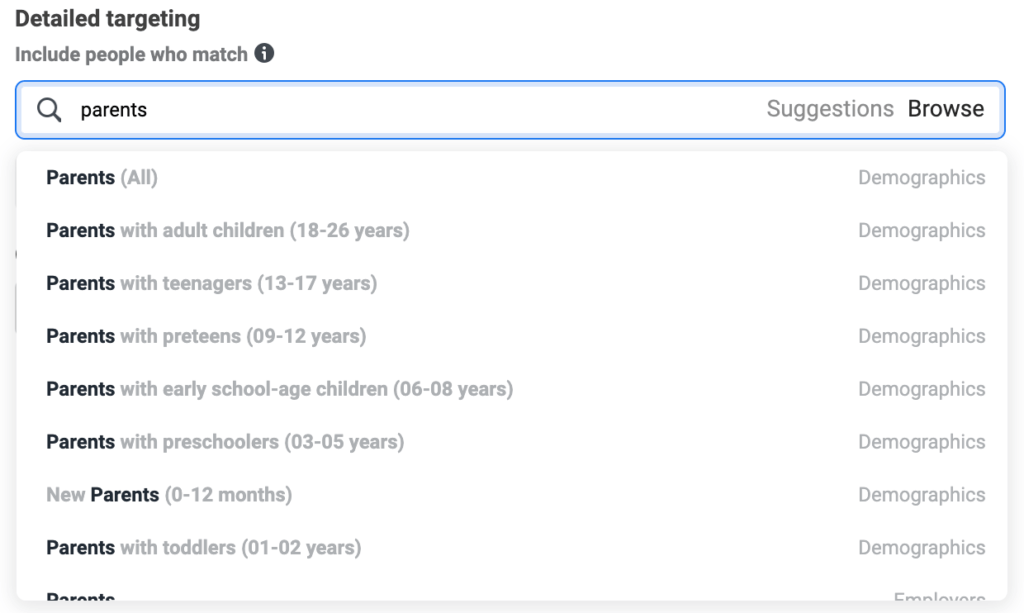The big hubbub with Facebook advertising right now is that audience targeting capabilities have taken a major blow from iOS and privacy changes. Facebook recently lost the ability to track many users across platforms and apps and even predicted a $10 billion revenue hit due to the change.
Additionally, advertisers (myself included) have witnessed some of our favorite Facebook detailed targeting options disappear from Ads Manager. This has made it more difficult to reach that ideal audience, causing some marketers to lower their ad spend or even abandon the platform altogether due to deteriorating results.
Which Facebook Detailed Targeting Options Are Disappearing
Meta’s original announcement back in late 2021 stated that the targeting options they planned to remove were outdated selections related to users’ personal interests and behaviors. Mainly, they were weeding out sensitive topics around organizations, figures, and causes. Here are a few categories they claimed would be covered by these changes:
- Health
- Religion
- Sexual Orientation
- Political Affiliations
- Race & Ethnicity
The intention was to avoid discrimination in ads. Although these changes did interfere with some targeting, especially for health organizations and non-profits, most advertisers understood the reasoning.
But then, Facebook removed even more targeting options, much to the dismay of small business owners and digital advertisers. Their reasoning? They claimed these options were, “either not widely used, they may be redundant with others, or too granular.”
Too granular?! Granular targeting is the reason why Facebook has been such a powerful platform to help us reach our ideal customers. These additional Facebook targeting changes are harder to understand and harder to work around.
How To Improve Your Targeting After Facebook Targeting Changes
 It’s not all doom and gloom. There are still ways to make the most out of the current Facebook targeting options.
It’s not all doom and gloom. There are still ways to make the most out of the current Facebook targeting options.
While Meta doesn’t make it easy for businesses, that doesn’t mean we can’t leverage every last tool available to zero in on our ideal customers. In fact, Facebook’s previous granular targeting may have made some advertisers a bit lazy, as targeting your ideal customer was quite easy. But if you can avoid some common Facebook ad mistakes, you can still leverage this popular platform and leave your competitors in the dust.
Let’s look at the five most common mistakes you can make when building an audience and of course, how to avoid them.
1. Changing Too Many Variables at Once
We’ve never been shy about being data nerds here at flyte. To optimize your ads to the max you need to collect clean and easy to understand data. Basically, we want to build proof around what works and what doesn’t.
There are so many elements that go into a campaign’s success. Visual creatives, text, landing pages, headlines, objectives, budget, and audiences. Meta will regularly tell you that bringing in new and different elements will help your ads stay exciting and fresh. And this is true to a degree.
 In most cases, you don’t want to serve the exact same ad to the exact same group of people over and over again. They’re likely to get tired of your content and click that “hide ad” option, effectively ending your relationship with them and demoting your brand in Meta’s eyes.
In most cases, you don’t want to serve the exact same ad to the exact same group of people over and over again. They’re likely to get tired of your content and click that “hide ad” option, effectively ending your relationship with them and demoting your brand in Meta’s eyes.
But you also can’t make changes willy-nilly or you’ll lose track of how each element affects the ad’s performance.
Picture this: you just ran a traffic campaign for your smoothie shop and you’re not thrilled with the results. You’re getting ready for your next campaign and really want to knock this one out of the park. You make a great new graphic, rewrite your caption, try a different URL, and you adjust your location targeting.
At the end of the month, the results look much better. Yay! But now you’re faced with a question: what exactly made the difference between the first campaign and this one? You’ll never know which variable caused the biggest change in your results because you switched them all at once. Therefore, you have no way of planning to repeat that success again in your next campaign.
I’m all for adjusting your audience targeting as you learn more about them and see which demographics are working best. But whatever you do, try to only change one variable at a time. One month you might add some new interests. Another, you could change your targeted age range. So on and so forth.
It’s helpful to keep a log of the dates and changes you make along the way–especially if you’re adjusting in the middle of a campaign. That way, when you review your performance charts and see spikes or dips, you can look back at your log to check if they correspond with any adjustments.
2. Not Using Facebook Audience Segmentation
It would be so simple if all of your customers responded to the same messaging and marketing tactics, but the reality is that each segment of your audience may be motivated by different reasons. Facebook advertisers often cast too wide a net onto a diverse audience they think could benefit from their products or services.
For example, we work with an organization that provides coaching, support, and resources to parents of students with learning differences. The families they’ve helped range from elementary aged kids to students making their journey to college. So it would make sense that their brand and services could appeal to many of the parents in Facebook detailed targeting options.

But the needs, pain points, and even vocabulary of the parents with middle schoolers vs. parents with college-aged children might be vastly different.
With the loss of user data due to iOS changes, Facebook’s demographic analytics have tanked. Sometimes advertisers can’t even see what age range or gender the audience who saw their ads fall into. The only reliable way to distinguish which demographics generate the best results for you is by segmenting your audience.
You can save specific audience groups in Meta Business Suite by navigating from Home → Advertise → Audiences and clicking the blue button to create a “Saved Audience” with detailed attributes. Then, plan campaigns that target one audience at a time and compare your results.
This strategy also allows you to tailor other elements of your ads to best resonate with that specific audience segment. Use imagery that visually represents the demographics you target or send them to a landing page that has specific resources for their group.
3. Watering Down Your Audience with Additional Interests
 As we’ve already said, using a broad audience can be problematic and inefficient. Even within a single audience segment you can still make targeting mistakes that broaden your group too far. This happens when advertisers don’t leverage the ability to narrow their audience, and instead only include additional interests or demographics.
As we’ve already said, using a broad audience can be problematic and inefficient. Even within a single audience segment you can still make targeting mistakes that broaden your group too far. This happens when advertisers don’t leverage the ability to narrow their audience, and instead only include additional interests or demographics.
Let me explain. Say I’m giving a talk titled, “Harry Potter and the Rise of Age-Agnostic Literary Consumption” and I want to put out some Facebook ads to promote attendance to the event.
I build my audience and add “Harry Potter,” and “TED Talks” to my interests. Seems like a perfect match, right? If your targeting looks something like this, you’re in trouble:

When you include people who match multiple interests it allows Facebook to widen its net and target anyone who meets at least one of your targeting options. That means my ads could be shown to muggles who are interested in TED Talks but don’t like Harry Potter… or vice versa.
Instead, what I should do is narrow my audience so that both of these important targeting factors are a required match. Basically, by narrowing I’m forcing Facebook to only show my ads to people who like both TED Talks and Harry Potter.

Narrowing ensures you are reaching people who most closely match your ideal customer. When there are important demographics or interests you should always add them by narrowing. Only in cases where you want to add interests that are essentially synonyms for one another, like the Harry Potter movies vs the Harry Potter fandom, should you group them together.

4. Not Excluding People Less Likely to Convert
While we’re on the topic of narrowing your audience, you should also take advantage of the option to exclude certain demographics and interests. It may seem counterintuitive to exclude people from seeing your ads but exclusions will help you avoid wasting money on unqualified leads.
Let’s continue with my Harry Potter TED Talk idea. The TED umbrella is quite big and I only want to reach people who are interested in attending my talk. I can zero in on this group by excluding subsets from TED. For example, I might choose to exclude anyone who works for TED. They almost certainly have an interest in TED Talks but for a completely different set of reasons than my ideal customer.
Exclusions can be used in lots of different situations:
- If you want to spread brand awareness to new people you might choose to exclude anyone who has seen ads from you before. That way you’re only reaching new audience members.
- You could be a real estate agent targeting people who have an interest in ‘Cottages’ or ‘Condominiums’ but you don’t want to end up targeting people who already recently purchased a home. Thus you could exclude the ‘Recently Moved’ demographic.
- If you’re advertising as a financial advisor, you might exclude anyone who holds that job title already to avoid having your ads hit competitors.
If you’re feeling overwhelmed, you don’t have to start with exclusions; they can be added along the way. Whenever you encounter an unqualified lead, try to figure out why and then use those attributes as audience exclusions.
5. Only Targeting Cold Audiences
Once upon a time, Facebook was a great platform for customer acquisition. But as we continue to see the impacts of iOS updates and changes to Facebook detailed targeting options, it seems more likely that the glory days are behind us. Facebook ads are no longer a sure-fire way to reach new people who fit your ideal customer profile.
You could still be struggling to reach the right people even with all the tips from above. But that may not spell the end for Facebook. Instead, you can shift your strategy and focus on retargeting customers that are already familiar with your brand. Rather than trying to acquire new leads, optimize ads that will move your existing audience further down your sales funnel.
There are a couple different retargeting options you can use that are more predictable than the limited Facebook detailed targeting:
- Website Retargeting: with the Pixel properly installed, you can retarget users who have visited your website or even a specific page.
- Email Retargeting: you can choose to upload your email list and use this to target current subscribers or even create lookalike audiences.
- In-Platform Retargeting: whether you want to retarget users who follow your Instagram account or anyone who has seen a video on your FB page, Facebook still keeps good track of people from within their platform.
Final Thoughts
Many business owners and advertisers are rethinking their relationship with Facebook, even going so far as to delete their Facebook business pages, or pursuing alternatives to Facebook ads. But there are still almost three billion daily Facebook & Instagram users that you could be targeting. With the right strategies and a little shift in mindset, Meta can still be a powerful tool for you to grow your business.
If you currently use Meta to run ads and are seeing some negative shifts in your results (or you just think they could be better) we’re here to help! We likely have some creative approaches to Facebook advertising that will get your ad strategy back on track and drive customers to your website.

Izzy joins flyte after moving to Portland in 2020, a city that is affably similar to her beloved Burlington, Vermont, with the added benefit of ocean air and fresh seafood. With a degree in English and a background in the nonprofit sector, she carries a curiosity for all things communications. From social media and email newsletters to website management and SEO, Izzy is involved. Reach out to Izzy today!
